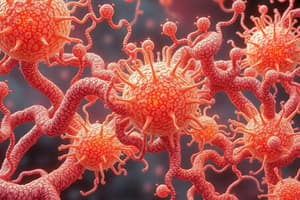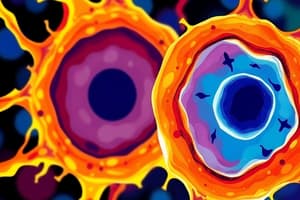Podcast
Questions and Answers
Which structure is NOT found in prokaryotic cells?
Which structure is NOT found in prokaryotic cells?
- Circular DNA
- Chloroplasts (correct)
- Plasmids
- Cell membrane
Calculate how many times longer the cell length is than the chloroplast length, given that the cell length is 50 micrometers and the chloroplast length is 6.25 micrometers.
Calculate how many times longer the cell length is than the chloroplast length, given that the cell length is 50 micrometers and the chloroplast length is 6.25 micrometers.
8
State two ways in which an animal cell would differ from a typical plant cell.
State two ways in which an animal cell would differ from a typical plant cell.
Animal cells lack a cell wall and chloroplasts.
Match the specialized cell with its function:
Match the specialized cell with its function:
Red blood cells contain a nucleus.
Red blood cells contain a nucleus.
Name the process by which cells become specialized.
Name the process by which cells become specialized.
How does DNA control the process of cell specialization?
How does DNA control the process of cell specialization?
State the meaning of the term 'stem cell'.
State the meaning of the term 'stem cell'.
Identify which structure is NOT found in animal cells.
Identify which structure is NOT found in animal cells.
Identify which of these substances is a carbohydrate stored in plant cells.
Identify which of these substances is a carbohydrate stored in plant cells.
Explain two ways that the structure of a palisade mesophyll cell is adapted for its function.
Explain two ways that the structure of a palisade mesophyll cell is adapted for its function.
Explain the importance of cell differentiation in the development of a growing embryo.
Explain the importance of cell differentiation in the development of a growing embryo.
Identify which of the following is a feature of adult stem cells?
Identify which of the following is a feature of adult stem cells?
Describe the functions of structures P, Q, and R in this diagram of a plant cell.
Describe the functions of structures P, Q, and R in this diagram of a plant cell.
This cell contains digestive enzymes. Identify one letter, from A-D, that corresponds to a cell that is described as containing digestive enzymes.
This cell contains digestive enzymes. Identify one letter, from A-D, that corresponds to a cell that is described as containing digestive enzymes.
This cell is involved in the co-ordination of the body's activities. Identify one letter, from A-D, that corresponds to a cell that is described as being involved in the co-ordination of the body's activities.
This cell is involved in the co-ordination of the body's activities. Identify one letter, from A-D, that corresponds to a cell that is described as being involved in the co-ordination of the body's activities.
Identify the organelle shown in the drawing of a human cheek cell.
Identify the organelle shown in the drawing of a human cheek cell.
Calculate the magnification of this drawing of a mitochondrion. The drawing shows a mitochondrion. The drawing's measured length is 60mm and the actual length of the mitochondrion is 6µm. (1 µm = 0.001 mm)
Calculate the magnification of this drawing of a mitochondrion. The drawing shows a mitochondrion. The drawing's measured length is 60mm and the actual length of the mitochondrion is 6µm. (1 µm = 0.001 mm)
What is the mean number of mitochondria per µm³ in a heart muscle cell, based on this data?
What is the mean number of mitochondria per µm³ in a heart muscle cell, based on this data?
Name the group of organisms from which the cell shown in the image has been taken. The cell has a Nucleus, X and Y.
Name the group of organisms from which the cell shown in the image has been taken. The cell has a Nucleus, X and Y.
Explain why structure Y (starch granule) is present inside structure X(Chloroplast), in the image.
Explain why structure Y (starch granule) is present inside structure X(Chloroplast), in the image.
Name three structures that are not clearly identifiable in the image in part (a) that you would expect to find inside cells from this group of organisms. a) The image below is an electron microscope photograph of a cell (a plant cell).
Name three structures that are not clearly identifiable in the image in part (a) that you would expect to find inside cells from this group of organisms. a) The image below is an electron microscope photograph of a cell (a plant cell).
Name structure X, Y and Z labelled in the image of a sperm cell.
Name structure X, Y and Z labelled in the image of a sperm cell.
Spermatogonial stem cells (SSCs) can be used to treat male infertility.
Spermatogonial stem cells (SSCs) can be used to treat male infertility.
Label the image with a letter D to indicate where the process of differentiation is occurring. A summary of spermatogenesis is shown in the image.
Label the image with a letter D to indicate where the process of differentiation is occurring. A summary of spermatogenesis is shown in the image.
What is taking place at letter D in order for differentiation to occur in spermatogenesis?
What is taking place at letter D in order for differentiation to occur in spermatogenesis?
Another example of a specialised cell is a ______ blood cell. One special feature of red blood cells is the absence of a nucleus.
Another example of a specialised cell is a ______ blood cell. One special feature of red blood cells is the absence of a nucleus.
Plants are one of the three groups of eukaryotes.
Plants are one of the three groups of eukaryotes.
What is the type of specialised plant cell visible in this image of a light microscope photograph of part of a plant root?
What is the type of specialised plant cell visible in this image of a light microscope photograph of part of a plant root?
Root hair cells help with transport in plants. Explain how the process of differentiation has allowed the cell in the image to carry out its specific function in plants.
Root hair cells help with transport in plants. Explain how the process of differentiation has allowed the cell in the image to carry out its specific function in plants.
Explain why the grass roots contain starch.
Explain why the grass roots contain starch.
Explain how the starch found in the roots of grass species helps to support growth of the grasses.
Explain how the starch found in the roots of grass species helps to support growth of the grasses.
Suggest an explanation for the change calculated in stored starch from January to October in the graph. The percentage increased by 1100%!
Suggest an explanation for the change calculated in stored starch from January to October in the graph. The percentage increased by 1100%!
Match the cell structure or process with its description.
Match the cell structure or process with its description.
Flashcards
What are Cell Organelles?
What are Cell Organelles?
Structures within cells that perform specific functions.
What is a Cell Membrane?
What is a Cell Membrane?
Controls what enters and exits a cell.
What is a Cell Wall?
What is a Cell Wall?
Provides support and shape to plant cells.
What is a Chloroplast?
What is a Chloroplast?
Signup and view all the flashcards
What are Plasmids?
What are Plasmids?
Signup and view all the flashcards
What is Starch?
What is Starch?
Signup and view all the flashcards
What is Glycogen?
What is Glycogen?
Signup and view all the flashcards
What is Cell Differentiation?
What is Cell Differentiation?
Signup and view all the flashcards
What are Stem Cells?
What are Stem Cells?
Signup and view all the flashcards
What are Embryonic Stem Cells?
What are Embryonic Stem Cells?
Signup and view all the flashcards
What are Adult Stem Cells?
What are Adult Stem Cells?
Signup and view all the flashcards
What is a Root Hair Cell?
What is a Root Hair Cell?
Signup and view all the flashcards
What is Spermatogenesis?
What is Spermatogenesis?
Signup and view all the flashcards
What is differentiation?
What is differentiation?
Signup and view all the flashcards
Study Notes
- Exam questions covering Cell Structure, Animal & Plant Cells (similarities and differences), the Importance of Cell Differentiation, and Stem Cells in Medicine (advantages & disadvantages).
- Exam consists of 15 questions
Types of Questions
- Easy questions total 36 marks
- Medium difficulty questions total 50 marks
- Hard questions total 54 marks
- Total exam marks available: 140
Studying That Suits You
Use AI to generate personalized quizzes and flashcards to suit your learning preferences.





